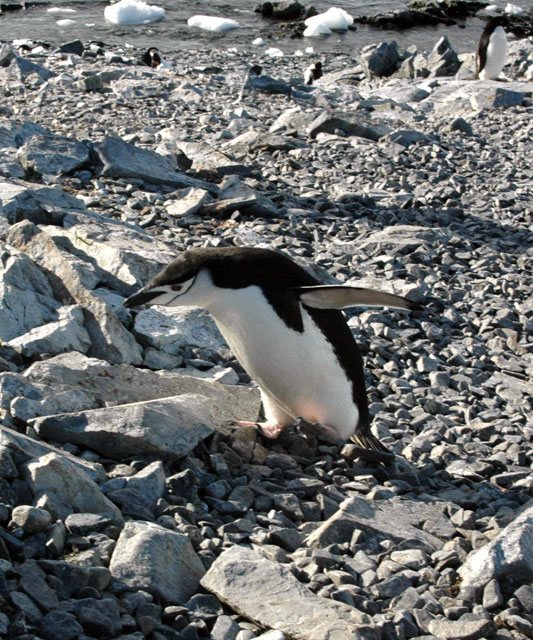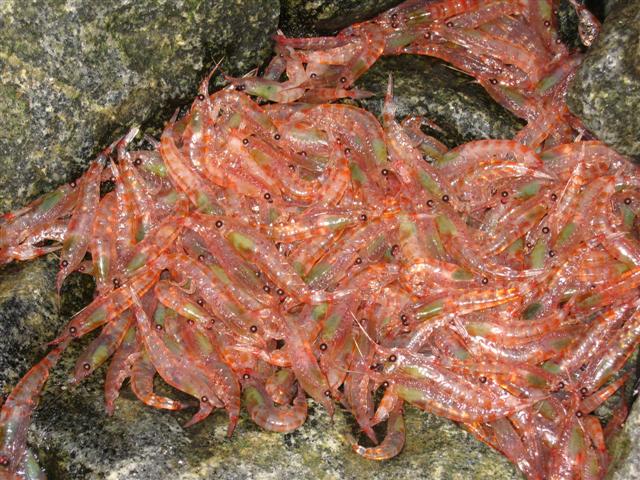Food shortageChanges in krill abundance blamed for penguin population declinePosted April 22, 2011
A decline in the abundance of a food favored by two species of penguins is the most likely cause for why the seabird populations are suffering along the western Antarctic Peninsula. That finding, published this month in the journal Proceedings of the National Academy of Sciences, is in contrast to the prevailing theory, which suggests a shrinking sea-ice habitat around the Antarctic Peninsula is directly responsible for declining numbers at penguin colonies on islands that different groups of researchers have monitored for several decades. The scientists looked at populations of Adélie penguins (Pygoscelis adeliae) and chinstrap penguins (Pygoscelis antarctica) throughout the western Antarctic Peninsula and Scotia Sea. The former favor a pack-ice habitat in the winter while the latter forage in ice-free water during the cold and dark months of the year. Both prey primarily on a shrimplike crustacean called krill (Euphausia superba). The peninsula is one of the fastest warming regions on the planet. Mean winter air temperatures have risen about 6 degrees Celsius over the last half-century. Conversely, winter sea ice duration in an area stretching from the west Antarctic Peninsula to the eastern Amundsen Sea shows a decline of about three months from 1979 to 2006. Sea ice is a critical habitat for both Adélie penguins and krill. Researchers have long believed that its decline would hurt both populations, while the more subantarctic chinstraps would be unaffected. But researchers from the National Oceanic and Atmospheric Administration (NOAA) “For penguins and other species, krill is the linchpin in the food web. Regardless of their environmental preferences, we see a connection between climate change and penguin populations through the loss of habitat for their main food source,” said Wayne Trivelpiece Although variability in sea ice remains a principal physical driver of the ecosystem, Trivelpiece and his co-authors suggest that “sea ice no longer drives trends in penguin populations through direct, physical effects on habitat. Rather, sea ice is one of several factors that mediate prey availability to penguins.” Added Trivelpiece in a press statement, “As warming continues, the loss of krill will have a profound effect throughout the Antarctic ecosystem.” The AERD conducts research for the U.S. Antarctic Marine Living Resources (AMLR) AERD just completed its 25th field season, which consists of six months of predator studies at two field stations and two one-month oceanographic surveys in the area surrounding the South Shetland Islands. The camps are operated in cooperation with the National Science Foundation The 30-year field study of Adélies and chinstraps shows that populations along the western Antarctic Peninsula and Scotia Sea have declined by an average 2.9 and 4.3 percent per year, respectively, for at least the last 10 years. Some colonies have decreased by more than 50 percent. Diet data collected during the last 30 years have shown that krill continue to dominate the diet of Adélie and chinstrap penguins despite an estimated 38 to 81 percent reduction in krill biomass during that period. Lack of an abundant supply of krill has been particularly hard on fledgling penguins that must learn where to locate and how to catch the prey on their own, having never been at sea before. Data from the study suggest that fewer young penguins are surviving this transition to independence today than in previous years when krill were much more abundant. Krill haven’t always been the favored food of penguins. Recent analyses of Adélie penguin diets using fossil eggshell material from extinct colonies revealed an abrupt shift in their diets within the last 200 years. [See previous article: Changing diet.] Some researchers believe the shift coincided with the mass slaughter of whales and other krill-eating species in the 19th and 20th centuries. Those animal populations are rebounding, meaning more competition for a prey species in decline. And humans are increasingly competing for the tiny crustacean as well. The fishery that operates in the region is expanding and recorded its largest catch in more than a decade, according to the authors. Catches nearly quadrupled from about 50,000 tons in 2002-03 to more than 200,000 tons in 2009-10. The authors suggest that the catches may only grow based on recent trends, such as the recent certification of one company’s krill fishing as being sustainable by the Marine Stewardship Council Trivelpiece noted that penguins are “excellent indicators” of ecosystem changes because “they are easily accessible while breeding on land, yet they depend entirely on food resources from the sea,” he said, adding they are not hunted by human unlike other krill predators such as whales and seals. “When we see steep declines in populations, as we have been documenting with both chinstrap and Adélie penguins, we know there's a much larger ecological problem,” he said.
NSF-funded research in this story: Wayne Trivelpiece, Susan Trivelpiece and George Watters, NOAA National Marine Fisheries Service, Award No. 0839129 |



For USAP Participants |
For The Public |
For Researchers and EducatorsContact UsU.S. National Science FoundationOffice of Polar Programs Geosciences Directorate 2415 Eisenhower Avenue, Suite W7100 Alexandria, VA 22314 Sign up for the NSF Office of Polar Programs newsletter and events. Feedback Form |




